
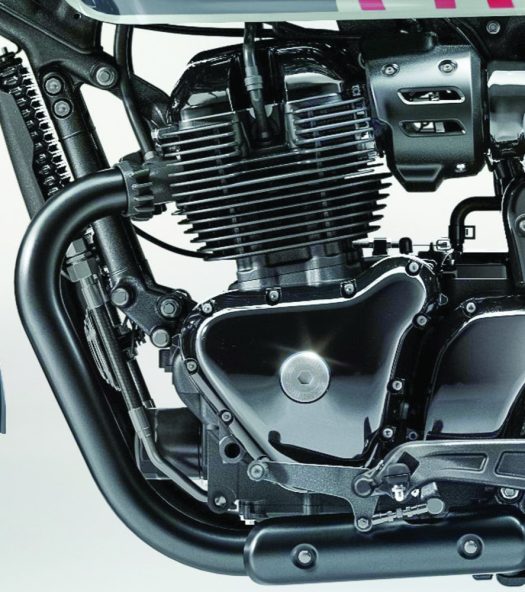
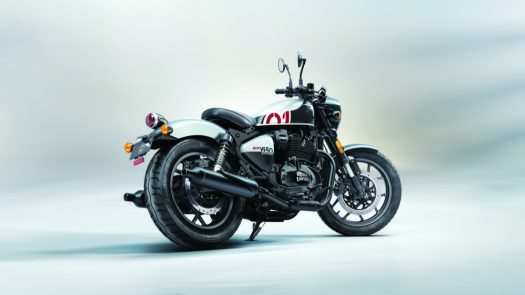
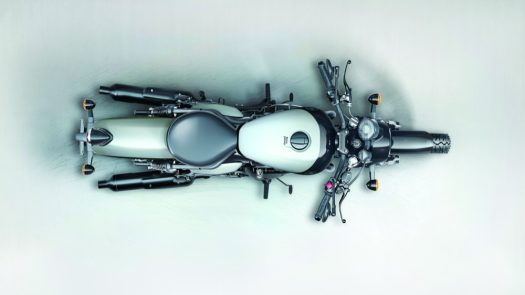
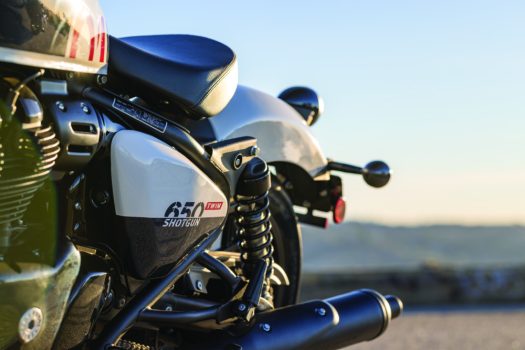
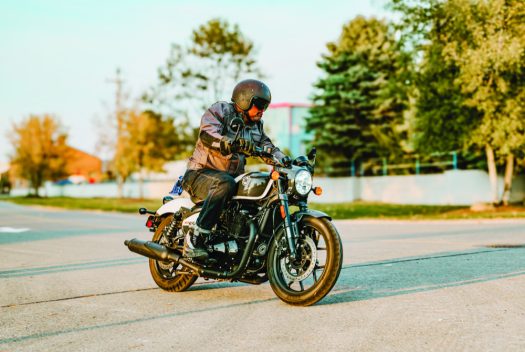
Story by Mike Seate • Photos by Nikki Marie Photography
As British manufacturers discovered more than half a century ago, line-ups can expand quite easily by designing new motorcycles around existing engine platforms. Indian’s Royal Enfield struck sales gold in 2018 with their versatile 650cc parallel twin engine introduced in the Continental GT cafe racer and Interceptor retro ride, expounding on the 48-horsepower mill with the Super Meteor cruiser in 2023. For ‘24, the Chennai team combined the GT’s on-point handling with the Super Meteor’s laid-back riding stance to create a machine that’s part muscle bike and part backroads scratcher.
How can a 530-pound machine with mid-ride footpegs and big steel fenders excel in the twisties? Easily, imagined Royal Enfield’s tech squad, who blessed the new machine with a sporty, 25.5-degree rake angle, 4 inches of trail, 5.5 inches of ground clearance and a nicely balanced tubular steel chassis that simply devours corners. The Shotgun’s running gear is also built for speed and plush handling, combining a set of inverted 43mm Showa Big Piston forks (with 4.5 inches of travel) with adjustable Showa twin rear shocks that bounce a full 3.5 inches. The bouncy bits somehow strike the perfect balance between firmness – which is needed when the going gets quick – and pliability, to prevent launching a rider out of the seat over bumps (like most Kawasakis of late).
The mid-ride footpegs, 30-inch seat height and wide flat handlebars make for a timely, neo-bobber riding position that should be familiar to anyone who has ridden a number of these 1950s-inspired rides, from Triumph’s Bonneville Bobber to Harley-Davidson’s Sportster S and Moto Guzzi’s V9.
While all of those motorcycles offer far more grunt and outright speed than the Shotgun, the broad spread of torque on offer here helps the Enfield punch a bit above its weight (no pun intended) on the road. Yes, it would lose a drag race with a bigger bike, but for the speeds at which we spend most of our riding time, the Shotgun’s powerband seldom feels underwhelming. In fact, Royal Enfield’s 650 twins have become global best-sellers because they deliver their power pulses right where riders need them – peak torque of 40 foot-pounds rumbles in through gear-driven cams at just 5,600 RPM, helping changes through the six-speed ‘box feel like the bike is being slingshotted, so to speak, from apex to apex.
Up front, a single 320mm floating disc with a two-piston ByBre caliper hauls down this beefy middleweight from rapid progress nicely, aided by a matching rear set-up squeezing a large 300mm rotor. It’s the strongest rear brake we’ve yet tested and dual-channel ABS is there to help in case of emergency stops should the need arise. CRM columnist Anthony Conroy enjoyed clocking some miles aboard the Shotgun, praising the easy, welcoming riding position and responsive direct fuel injection. Conroy wished for a second front disc, but one stamp down on that very effective rear brake pedal put those wishes to rest.
Show the Shotgun a long flat straight, and the motor eagerly gallops along. Park it in fourth gear and let torque do the rest. Try as I might, I couldn’t scrape a footpeg, even when leaning the bike over far more than 50-degree weather allowed. Funny thing is, with a good set of tires, it could have easily scraped pavement.
The stock tires are an area where improvement is undeniably needed. The 150×17 rear and 100×18 front are both budget-built CEAT bias-plys, lacking both the tactile feel of radials and the cornering confidence afforded by sportier compound rubber. Web forums and owner’s sites are rife with quests to find the best hoops for a bike with so much cornering potential and we’re outfitting ours with a pair of Avon Cobra Chrome radials ASAP.
The press materials emphasize the Shotgun’s eagerness to be customized, and the design brief backs this up: the rear subframe can be unbolted easily for a cleaner look while a thick catalog of RE-branded accessories followed the 650 into showrooms. There’s a clever use of color and shapes at work from the 1960s-style headlight surround to the bobbed rear fender, blacked-out engine and slotted fuel injector covers. Our Shotgun’s two-tone gray/white livery with bold red letters has drawn more than its share of compliments, attesting to the company’s longstanding attention to design detail. Not so groovy are the heavy, restrictive exhausts that will be canned for something lighter and louder by the time you read this.
Tech heads will enjoy the neat round gauge that combines digital readouts with a sweeping analog (look) tach. The Tripper satellite navigation system sits adjacent, offering a smartphone app-enabled program that helps with finding one’s way there and back.
So where does this do-it-all 650 fit in? Well, for folks desiring a motorcycle that’s speedy (just enough) for backroads thrills without the neck pain and insurance costs of a sportbike; for cruiser fans who don’t need the excess weight of American-made iron; for the tech-curious who’ve always yearned to customize a streetbike, but don’t want to invest five figures in a donor bike. These are all great reasons to pull the trigger (sorry, couldn’t resist) on a Shotgun 650. CR
Royal Enfield Shotgun 650
MSRP: $6,699
Engine: Air and oil-cooled SOHC eight-valve 650 twin
Transmission: Six-speed
Brakes: Single, two-piston ByBre front caliper with 320mm rotor: Two-piston ByBre rear caliper with 300mm rotor; ABS included.
Wheels: Cast aluminum, 18” front, 17” rear
Suspension: 43mm, non-adjustable inverted Showa Big Piston forks with 4.5” travel: Twin preload-adjustable Showa shocks with 3.5” travel
Power: 48 horsepower @ 7,250 RPM; 40 foot-pounds torque at 5,600 RPM
Electronics: Dual-channel ABS, electronic fuel injection, Tripper navigation system
Fuel Capacity/economy: 3.6 US gallons @ 60 MPG
Colors: Gray/White, olive green, sheetmetal gray, blue.
We Dig: The spot-on bobber styling
We’d Ditch: The mufflers. It’s always the bloody mufflers!
Power Cruisers Assemble
As a relatively new segment of the streebike market, so-called power cruisers have been well-received by the riding public. Loosely defined as low-slung machines with beefed up engines and sporty suspension, these musclebikes offer more than traditional feet-forward, low-output boulevard cruisers while not taxing the body (or insurance premiums) in the way of sportier machines. Here’s a few of the better examples we’ve tested in recent years.
Triumph Bonneville Bobber
The original factory bobber, this stubby, 120cc water-cooled parallel twin has oomph to spare thanks to its tuning that emphasizes midrange stomp over outright horsepower. Rear monoshock offers the best travel of any bike in its class, making the Triumph more rideable and better in corners than most.
Harley-Davidson Sportster 1250S
Radical e-imagining of the 75 year-old XL Sportster line, the new model runs Harley-Davidson’s race-proven, 60 degree Revolution max engine. The exhaust note may be different, but no one can argue with 80 foot pounds and 125 horses in a bike with a short wheelbase and seriously sporty Showa inverted forks. ‘Tis a pity that rear suspension travels on 1 ¾” making for a rough ride.
Moto Guzzi V9 Bobber
The Italian answer to Triumph’s Bonneville Bobber is a fun, capable machine with unusual looks and loads of character. Not the fastest at 58 rear wheel horses, the Guzzi still handles well even with fat, 16” tires. Ohlins shocks and maintenance-free shaft drive are a plus as is the relatively low entry price of just under $9K new.
Honda Rebel 1100
Typical Honda smoothness and refinement along with a dual-action clutch makes the biggest Rebel a smart choice. Clutch-free shifting and a thudding 1100cc water-cooled parallel twin motor plus easy customization make for a reliable, fun ride. Low seat height in a plus for shorties.